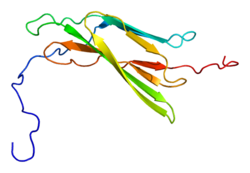| MERTK |
|---|
 |
| Structure de la protéine MERTK. Basé sur l'identifiant PDB 2DBJ. |
| Structures disponibles |
|---|
| PDB | Recherche d'orthologue: PDBe RCSB |
|---|
| Identifiants PDB |
|---|
2DBJ, 2P0C, 3BPR, 3BRB, 3TCP, 4M3Q, 4MH7, 4MHA |
|
|
| Identifiants |
|---|
| Aliases | MERTK, myeloid-epithelial-reproductive tyrosine kinase |
|---|
| IDs externes | OMIM: 604705 MGI: 96965 HomoloGene: 4626 GeneCards: MERTK |
|---|
| Position du gène (Homme) |
|---|
 | | Chr. | Chromosome 2 humain[1] |
|---|
| | Locus | 2q13 | Début | 111,898,607 bp[1] |
|---|
| Fin | 112,029,561 bp[1] |
|---|
|
| Position du gène (Souris) |
|---|
 | | Chr. | Chromosome 2 (souris)[2] |
|---|
| | Locus | 2|2 F1 | Début | 128,540,876 bp[2] |
|---|
| Fin | 128,644,814 bp[2] |
|---|
|
| Expression génétique |
|---|
| Bgee | | Humain | Souris (orthologue) |
|---|
| Fortement exprimé dans | - right adrenal cortex
- muqueuse gastrique
- left adrenal gland
- left adrenal cortex
- artère poplitée
- Tibial arteries
- Descending thoracic aorta
- aorte ascendante
- artère coronaire gauche
- rate
|
| | Fortement exprimé dans | - stroma of bone marrow
- tunica media of zone of aorta
- épithélium pigmentaire rétinien
- Jéjunum
- aorte ascendante
- iléon
- corps du fémur
- rate
- duodénum
- right kidney
|
| | Plus de données d'expression de référence |
|
|---|
| BioGPS | |
|---|
|
| Gene Ontology |
|---|
| Fonction moléculaire | - liaison ATP
- protein tyrosine kinase activity
- protein kinase activity
- liaison protéique
- transmembrane receptor protein tyrosine kinase activity
- activité kinase
- liaison nucléotide
- activité de transférase
- Récepteurs à activité tyrosine kinase
- transmembrane signaling receptor activity
- Wnt-protein binding
| | Composant cellulaire | - integral component of membrane
- photoreceptor outer segment
- rhabdomere
- membrane
- integral component of plasma membrane
- membrane plasmique
- cytoplasme
- milieu extracellulaire
- receptor complex
| | Processus biologique | - spermatogenèse
- vagina development
- protein kinase B signaling
- natural killer cell differentiation
- cell surface receptor signaling pathway
- phosphorylation des protéines
- platelet activation
- cell-cell signaling
- positive regulation of phagocytosis
- apoptotic cell clearance
- substrate adhesion-dependent cell spreading
- leukocyte migration
- negative regulation of lymphocyte activation
- phosphorylation
- retina development in camera-type eye
- negative regulation of leukocyte apoptotic process
- phagocytose
- secretion by cell
- peptidyl-tyrosine phosphorylation
- negative regulation of cytokine production
- neutrophil clearance
- negative regulation of signal transduction
- Voie de signalisation Wnt
- différenciation cellulaire
- negative regulation of apoptotic process
- positive regulation of ERK1 and ERK2 cascade
- transmembrane receptor protein tyrosine kinase signaling pathway
- neurodéveloppement
- migration cellulaire
| | Sources:Amigo / QuickGO |
|
| Orthologues |
|---|
| Espèces | Homme | Souris |
|---|
| Entrez | | |
|---|
| Ensembl | | |
|---|
| UniProt | | |
|---|
| RefSeq (mRNA) | | |
|---|
| RefSeq (protéine) | | |
|---|
| Localisation (UCSC) | Chr 2: 111.9 – 112.03 Mb | Chr 2: 128.54 – 128.64 Mb |
|---|
| Publication PubMed | [3] | [4] |
|---|
|
| Wikidata |
| Voir/Editer Humain | Voir/Editer Souris |
|

 Portail de la biologie cellulaire et moléculaire
Portail de la biologie cellulaire et moléculaire 
















